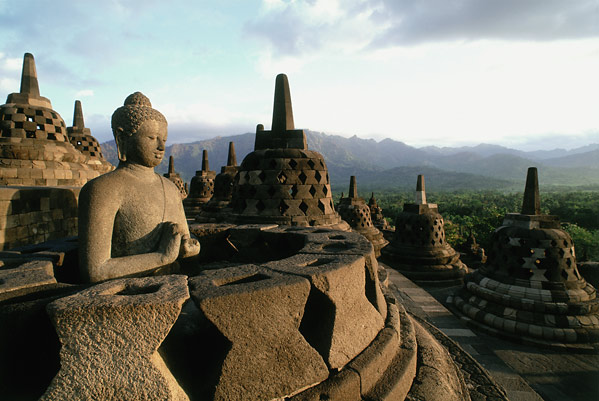During Egypt's Old Kingdom (time line), the pharaohs established a stable central government in the fertile Nile Valley. Perhaps the greatest testaments to their power were the pyramids and other tombs built to shelter them in the afterlife.
Pyramids Egypt
Kings of the Dead
Ancient Egyptians believed that when the pharaoh died, he became Osiris, king of the dead. The new pharaoh became Horus, god of the heavens and protector of the sun god. This cycle was symbolized by the rising and setting of the sun.
Some part of a dead pharaoh's spirit, called his ka, was believed to remain with his body. And it was thought that if the corpse did not have proper care, the former pharaoh would not be able to carry out his new duties as king of the dead. If this happened, the cycle would be broken and disaster would befall Egypt.
To prevent such a catastrophe, each dead pharaoh was mummified, which preserved his body. Everything the king would need in his afterlife was provided in his grave—vessels made of clay, stone, and gold, furniture, food, even doll-like representations of servants, known as ushabti. His body would continue to receive food offerings long after his death.
Tombs Fit for Kings
To shelter and safeguard the part of a pharaoh's soul that remained with his corpse, Egyptians built massive tombs—but not always pyramids.
Before the pyramids, tombs were carved into bedrock and topped by flat-roofed structures called mastabas. Mounds of dirt, in turn, sometimes topped the structures.
The pyramid shape of later tombs could have come from these mounds. More likely, Egyptian pyramids were modeled on a sacred, pointed stone called the benben. The benben symbolized the rays of the sun; ancient texts claimed that pharaohs reached the heavens via sunbeams.
Who Built the Pyramids?
Contrary to some popular depictions, the pyramid builders were not slaves or foreigners. Excavated skeletons show that they were Egyptians who lived in villages developed and overseen by the pharaoh's supervisors.
The builders' villages boasted bakers, butchers, brewers, granaries, houses, cemeteries, and probably even some sorts of health-care facilities—there is evidence of laborers surviving crushed or amputated limbs. Bakeries excavated near the Great Pyramids could have produced thousands of loaves of bread every week.
Some of the builders were permanent employees of the pharaoh. Others were conscripted for a limited time from local villages. Some may have been women: Although no depictions of women builders have been found, some female skeletons show wear that suggests they labored with heavy stone for long periods of time.
Graffiti indicates that at least some of these workers took pride in their work, calling their teams "Friends of Khufu," "Drunkards of Menkaure," and so on—names indicating allegiances to pharaohs.
An estimated 20,000 to 30,000 workers built the Pyramids at Giza over 80 years. Much of the work probably happened while the River Nile was flooded.
Huge limestone blocks could be floated from quarries right to the base of the Pyramids. The stones would likely then be polished by hand and pushed up ramps to their intended positions.
It took more than manual labor, though. Architects achieved an accurate pyramid shape by running ropes from the outer corners up to the planned summit, to make sure the stones were positioned correctly. And priests-astronomers helped choose the pyramids' sites and orientations, so that they would be on the appropriate axis in relation to sacred constellations.
From stone pusher to priest, every worker would likely have recognized his or her role in continuing the life-and-death cycle of the pharaohs, and thereby in perpetuating the glory of Egypt
STEPPING TOWARD A TRUE PYRAMID
Intended to hold his mummified body, Pharaoh Djoser's Step Pyramid at Saqqara began as a traditional, flat-roofed mastaba. But by the end of his 19-year reign, in 2611 B.C., it had risen to six stepped layers and stood 204 feet (62 meters) high. It was the largest building of its time.
Extensive use of stone—here and there carved to resemble wood, reeds, or other softer materials—made the tomb more durable than its mud-brick forebears. Such pioneering techniques led many ancient historians to credit the chief architect, Imhotep, with inventing stone architecture.
The Step Pyramid complex was enclosed by a 30-foot (10-meter) wall and included courtyards, temples, and chapels covering nearly 40 acres (16 hectares)—the size of a large town in the third millennium B.C.
As in earlier mastaba tombs, the Step Pyramid's burial chambers are underground, hidden in a maze of tunnels, probably to discourage grave robbers. The tomb was nevertheless plundered, and all that remains of Djoser, the third king of Egypt's 3rd dynasty (time line), is his mummified left foot.
CLASSIC FACT: Imhotep—architect of the Step Pyramid, physician, priest, and founder of a cult of healing—was deified 1,400 years after his lifetime.









